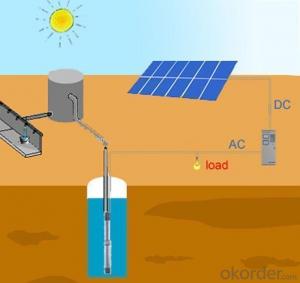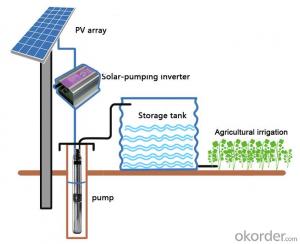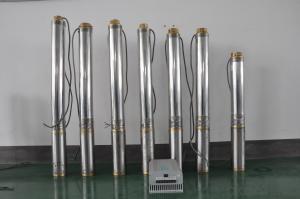Solar Powered Pond Pump Solar Water Pumps
- Loading Port:
- Shanghai
- Payment Terms:
- TT OR LC
- Min Order Qty:
- 1 set
- Supply Capability:
- 1000 set/month
OKorder Service Pledge
OKorder Financial Service
You Might Also Like
Solar Water Pump
DC solar water pumping system consists of the motor, pump, controller, solar array and some other accessories, such as water level sensor, float switch, etc. Considered that storing water is more efficient than storing electricity, the system is designed to directly drive the pump without battery which can reduce the construction and operating cost and routine maintenance effectively.The PV array consists of multiple solar panels connected in series/parallel, which can supply the whole system as power source by converting the absorbed solar radiation energy to the electrical energy. The pump driven by a brushless DC permanent magnet motor draws water from deep-well or river. The pumped water is then fed into reservoir or water tank, or connected to the irrigation system or fountain system directly.
Advanced Technology
Applications Innovation
The efficiency of DC brushless permanent magnet motor has been increased up to 25% in comparison with traditional asynchronous motor.
Technology Innovation
Stator and rotor are sealed by environment friendly casting resin.Motor insulation resistance can be hold higher than 300MΩfor more than 10 years, which consumedly increased the security and reliability of the submersible motor.
Structure Innovation
Casting resign technology processed stator and rotor as well as the water lubricated bearing make the submersible pump environment friendly.
Feature
High Efficiency & High Reliability
DC Brushless Permanent Magnet Motor
Minimum Maintenance, long Service Life
Environment Friendly Materials, Lubricated Without Oil
Application
Village or Family Water Supply
Animal Drinking Water & Livestock Watering
Garden/Courtyard Irrigation
Swimming Pool
Water Supply for Bivouac or Camping Car
Water Supply for Remote Area
Automatic Control
Operate Automatically, No Need Watching
Maximum Power Point Tracking (MPPT)
Dry-run Protection
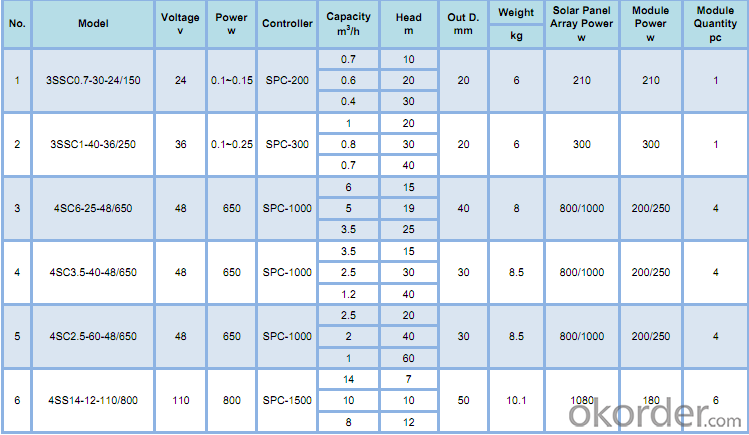
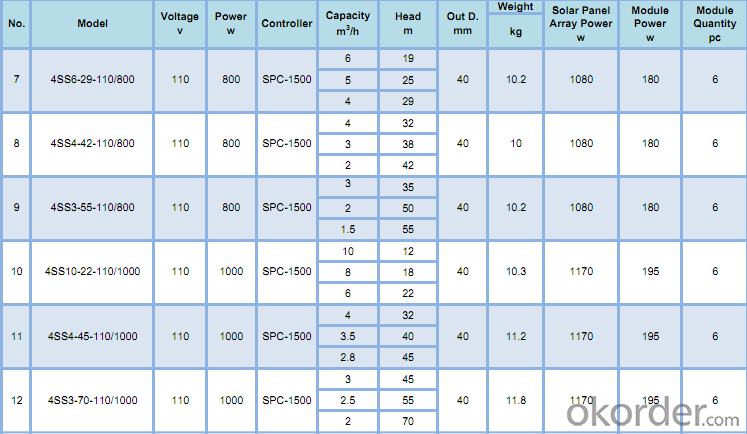
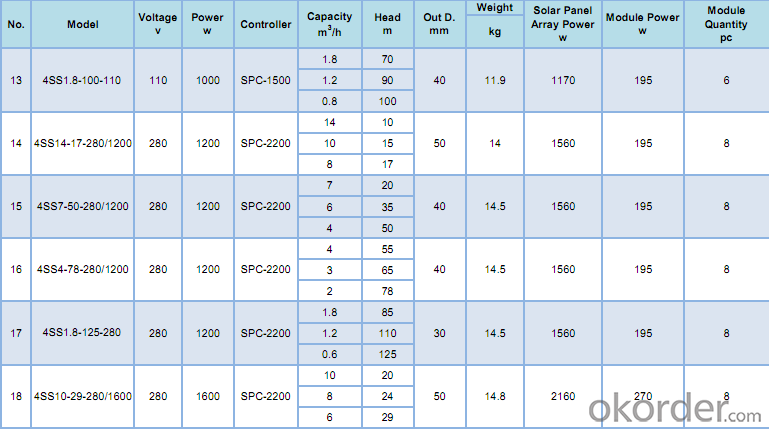
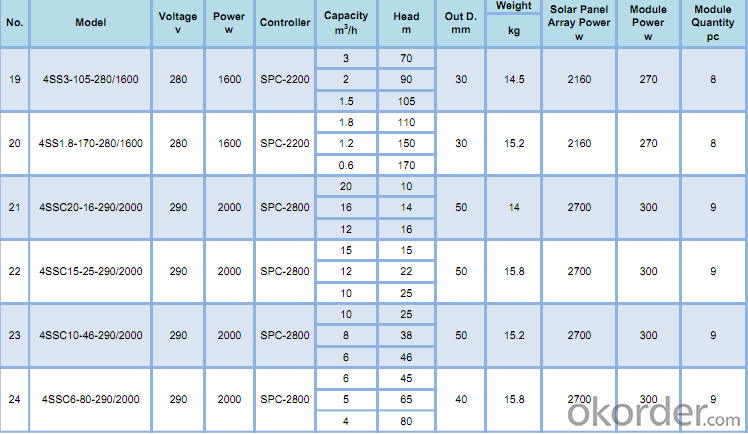

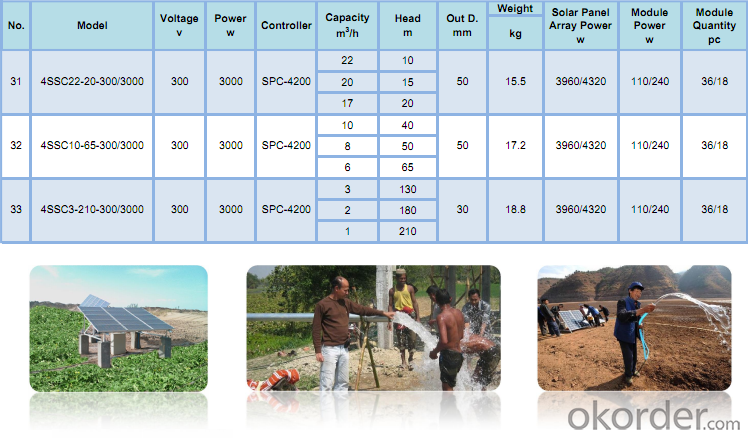
- Q:Can a solar pump be used for water circulation in a swimming pool?
- Yes, a solar pump can be used for water circulation in a swimming pool. Solar pumps are designed to use energy from the sun to power the circulation of water. They are environmentally friendly and cost-effective options for maintaining water circulation and filtration in a swimming pool.
- Q:Can a solar pump be used in disaster relief efforts?
- Yes, a solar pump can be used in disaster relief efforts. Solar pumps are a sustainable and reliable solution for providing clean water in disaster-stricken areas where traditional power sources may be unavailable or unreliable. They can be used to extract water from wells, rivers, or other water sources, helping to meet the basic needs of affected communities during emergencies. Additionally, their low maintenance requirements and ability to operate independently from the electrical grid make them practical and efficient options for disaster relief operations.
- Q:How does a solar pump help in reducing the use of chemical fertilizers?
- A solar pump helps in reducing the use of chemical fertilizers by providing a sustainable source of water for irrigation. With a solar pump, farmers can efficiently water their crops using solar energy, reducing the reliance on fossil fuel-powered pumps. This enables farmers to better regulate the amount of water used, preventing over-irrigation which can lead to the leaching of nutrients and the need for additional chemical fertilizers. Additionally, solar pumps can be paired with drip irrigation systems, which deliver water directly to the plant's roots, minimizing water wastage and ensuring that fertilizers are efficiently utilized by the crops.
- Q:What is the maximum size of particles that a solar pump can handle?
- The maximum size of particles that a solar pump can handle varies depending on the specific model and design. In general, solar pumps are designed to handle small to medium-sized particles. These can include dirt, sand, small pebbles, and other debris that may be present in the water source. The size limit is typically determined by the pump's impeller or filtration system. It is important to consult the manufacturer's specifications or guidelines to determine the maximum particle size that a particular solar pump can handle.
- Q:What types of solar pumps are available in the market?
- There are several types of solar pumps available in the market, including submersible solar pumps, surface solar pumps, and floating solar pumps.
- Q:Can a solar pump be used in areas with limited access to water pumps?
- Yes, a solar pump can be used in areas with limited access to water pumps. Solar pumps are a great alternative in remote or off-grid locations with limited infrastructure. They rely on solar energy to power their operation, making them independent of the electrical grid and reducing the need for traditional water pumps that require electricity or fuel. Solar pumps are efficient, cost-effective, and environmentally friendly solutions for providing access to water in areas where traditional pumps may not be feasible.
- Q:Are solar pumps cost-effective compared to traditional pumps?
- Yes, solar pumps are cost-effective compared to traditional pumps. While the initial upfront cost of installing a solar pump may be higher, they have significantly lower operational costs as they rely on free and renewable solar energy to power them. Traditional pumps, on the other hand, require electricity or fuel, which can be expensive and subject to price fluctuations. Additionally, solar pumps have lower maintenance costs and longer lifespans, resulting in overall cost savings in the long run.
- Q:What is the maximum temperature range in which a solar pump can operate?
- The maximum temperature range in which a solar pump can operate typically depends on the specific model and design, but most solar pumps can function within a temperature range of -20°C to 50°C (-4°F to 122°F).
- Q:How do I troubleshoot common issues with a solar pump system?
- To troubleshoot and resolve issues with your solar pump system, a systematic approach can be taken. Here are some steps that can be helpful: 1. Ensure the power supply: Make sure that the solar panels are receiving enough sunlight and that the battery is fully charged. It is important to check for any loose connections or damaged wires that may affect the power supply. 2. Examine the pump: Inspect the pump for any visible signs of damage or blockages. Removing any debris or obstructions that may hinder the pump's operation is important. 3. Verify the water source: Confirm that the water source is not depleted or contaminated. Check if the intake or filter is clogged, as this can restrict water flow. Cleaning or replacing the filter, if necessary, is recommended. 4. Assess the water level: Make sure that the water level is sufficient for the pump to work properly. If the water level is too low, the pump may not prime or function optimally. Adjusting the pump's depth accordingly is necessary. 5. Inspect the tubing and connections: Check for any leaks, cracks, or loose connections in the tubing system. It is important to tighten or replace any faulty connections to prevent water and pressure loss. 6. Evaluate the controller settings: Review the settings of the controller and ensure that they are properly configured for your specific system requirements. If necessary, adjust the settings such as pump speed or timing. 7. Monitor system performance: Observe the system's performance and watch for any unusual noises, vibrations, or fluctuations in water flow. These may indicate underlying issues that require further investigation. 8. Consult the manufacturer's manual: Refer to the manufacturer's manual or documentation for specific troubleshooting tips and guidance. They may provide detailed instructions for resolving common issues related to your solar pump system. 9. Seek professional assistance if needed: If you have tried all troubleshooting steps and are still experiencing problems, it may be beneficial to contact a professional solar pump technician or the manufacturer's customer support for further assistance and guidance. By following these troubleshooting steps, you can effectively identify and resolve common issues with your solar pump system, ensuring its optimal functioning and longevity.
- Q:How does a solar pump help in reducing reliance on grid electricity?
- A solar pump reduces reliance on grid electricity by utilizing solar energy to power the pump, eliminating the need for electricity from the grid. This not only reduces the overall electricity consumption but also decreases the reliance on fossil fuel-based power sources, leading to a more sustainable and environmentally friendly solution.
1. Manufacturer Overview |
|
|---|---|
| Location | |
| Year Established | |
| Annual Output Value | |
| Main Markets | |
| Company Certifications | |
2. Manufacturer Certificates |
|
|---|---|
| a) Certification Name | |
| Range | |
| Reference | |
| Validity Period | |
3. Manufacturer Capability |
|
|---|---|
| a)Trade Capacity | |
| Nearest Port | |
| Export Percentage | |
| No.of Employees in Trade Department | |
| Language Spoken: | |
| b)Factory Information | |
| Factory Size: | |
| No. of Production Lines | |
| Contract Manufacturing | |
| Product Price Range | |
Send your message to us
Solar Powered Pond Pump Solar Water Pumps
- Loading Port:
- Shanghai
- Payment Terms:
- TT OR LC
- Min Order Qty:
- 1 set
- Supply Capability:
- 1000 set/month
OKorder Service Pledge
OKorder Financial Service
Similar products
New products
Hot products
Hot Searches
Related keywords
